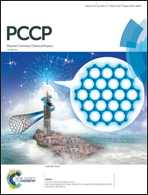Unraveling the structure and exciton coupling for multichromophoric merocyanine dye molecules†
Abstract
The relative orientation of chromophores is a key factor in determining the relationship between the structure and the functionality in molecular multichromophore ensembles. In the case of structurally flexible molecular systems in solution, the task to clarify the relevant effects of accessible chromophore orientations with spectroscopic observations is very demanding. In this study, we address this issue by investigating a series of differently connected multichromophoric systems composed of highly dipolar merocyanine dyes that are systematically varied in their substitution pattern and the number of chromophores attached to a bridging benzene ring. Combining electro-optical absorption (EOA) and UV/Vis spectroscopy with density functional theory (DFT) as well as exciton theory discloses conformational preferences and rationalizes the optical properties of the interacting chromophores. Our findings suggest for all multichromophoric systems there is a relative orientation of the chromophores which compensates for the individual dipole moments of the merocyanine dyes by pointing preferably in opposing directions. These orientations furthermore rationalize the observed spectral properties by partly excitonically-coupled subunits.

- This article is part of the themed collection: 2017 PCCP HOT Articles


 Please wait while we load your content...
Please wait while we load your content...